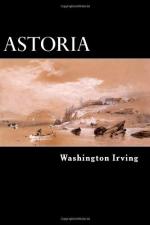After their departure, Mr. Hunt turned his thoughts to another object of importance. He had now arrived at the head waters of the Columbia, which were among the main points embraced by the enterprise of Mr. Astor. These upper streams were reputed to abound in beaver, and had as yet been unmolested by the white trapper. The numerous signs of beaver met with during the recent search for timber gave evidence that the neighborhood was a good “trapping ground.” Here, then, it was proper to begin to cast loose those leashes of hardy trappers, that are detached from trading parties, in the very heart of the wilderness. The men detached in the present instance were Alexander Carson, Louis St. Michel, Pierre Detaye, and Pierre Delaunay. Trappers generally go in pairs, that they may assist, protect, and comfort each other in their lonely and perilous occupations. Thus Carson and St. Michel formed one couple, and Detaye and Delaunay another. They were fitted out with traps, arms, ammunition, horses, and every other requisite, and were to trap upon the upper part of Mad River, and upon the neighboring streams of the mountains. This would probably occupy them for some months; and, when they should have collected a sufficient quantity of peltries, they were to pack them upon their horses and make the best of their way to the mouth of Columbia River, or to any intermediate post which might be established by the company. They took leave of their comrades and started off on their several courses with stout hearts and cheerful countenances; though these lonely cruisings into a wild and hostile wilderness seem to the uninitiated equivalent to being cast adrift in the ship’s yawl in the midst of the ocean.
Of the perils that attend the lonely trapper, the reader will have sufficient proof, when he comes, in the after part of this work, to learn the hard fortunes of these poor fellows in the course of their wild peregrinations.
The trappers had not long departed, when two Snake Indians wandered into the camp. When they perceived that the strangers were fabricating canoes, they shook their heads and gave them to understand that the river was not navigable. Their information, however, was scoffed at by some of the party, who were obstinately bent on embarkation, but was confirmed by the exploring party, who returned after several days’ absence. They had kept along the river with great difficulty for two days, and found it a narrow, crooked, turbulent stream, confined in a rocky channel, with many rapids, and occasionally overhung with precipices. From the summit of one of these they had caught a bird’s-eye view of its boisterous career for a great distance through the heart of the mountain, with impending rocks and cliffs. Satisfied from this view that it was useless to follow its course, either by land or water, they had given up all further investigation.




